Strategy Management Report: Fast Food Industry and Global Strategies
VerifiedAdded on 2020/05/11
|20
|3444
|84
Report
AI Summary
This comprehensive report provides a detailed analysis of strategy management within the fast food industry. It begins with a competitive forces analysis, exploring the industry's dynamics and the strategies employed to enhance profitability. The report then identifies and examines the global strategies of prominent companies such as Apple, Virgin, British Petroleum, and McDonald's, offering insights into their approaches to market penetration and competitive advantage. Furthermore, it addresses the reasons behind multinational companies adopting localization strategies and maintaining them amidst competition. The report concludes by exploring the structure, control, and culture of various organizational types, including small manufacturing companies, chain stores, and large international banks, providing a holistic view of strategic management across diverse business contexts.
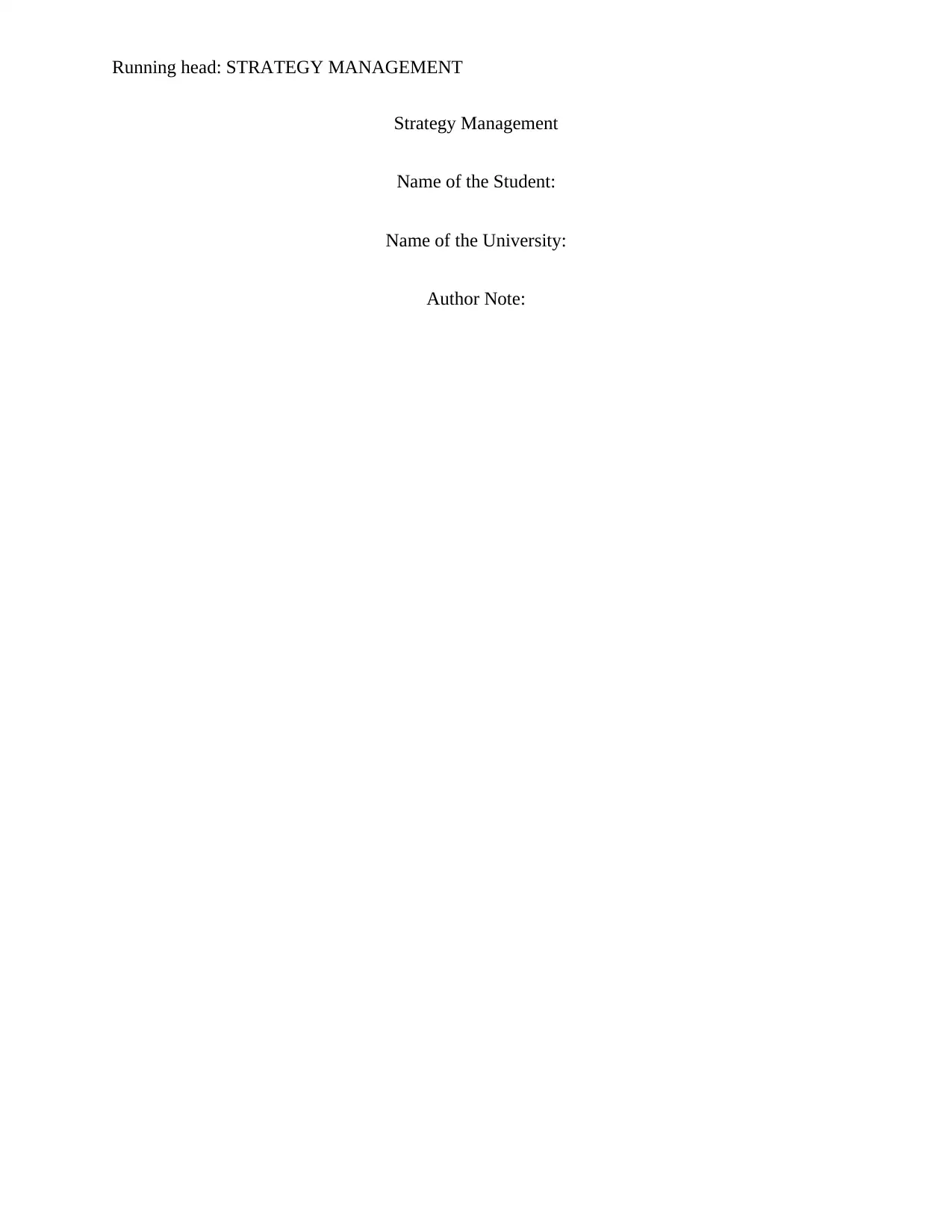
Running head: STRATEGY MANAGEMENT
Strategy Management
Name of the Student:
Name of the University:
Author Note:
Strategy Management
Name of the Student:
Name of the University:
Author Note:
Paraphrase This Document
Need a fresh take? Get an instant paraphrase of this document with our AI Paraphraser
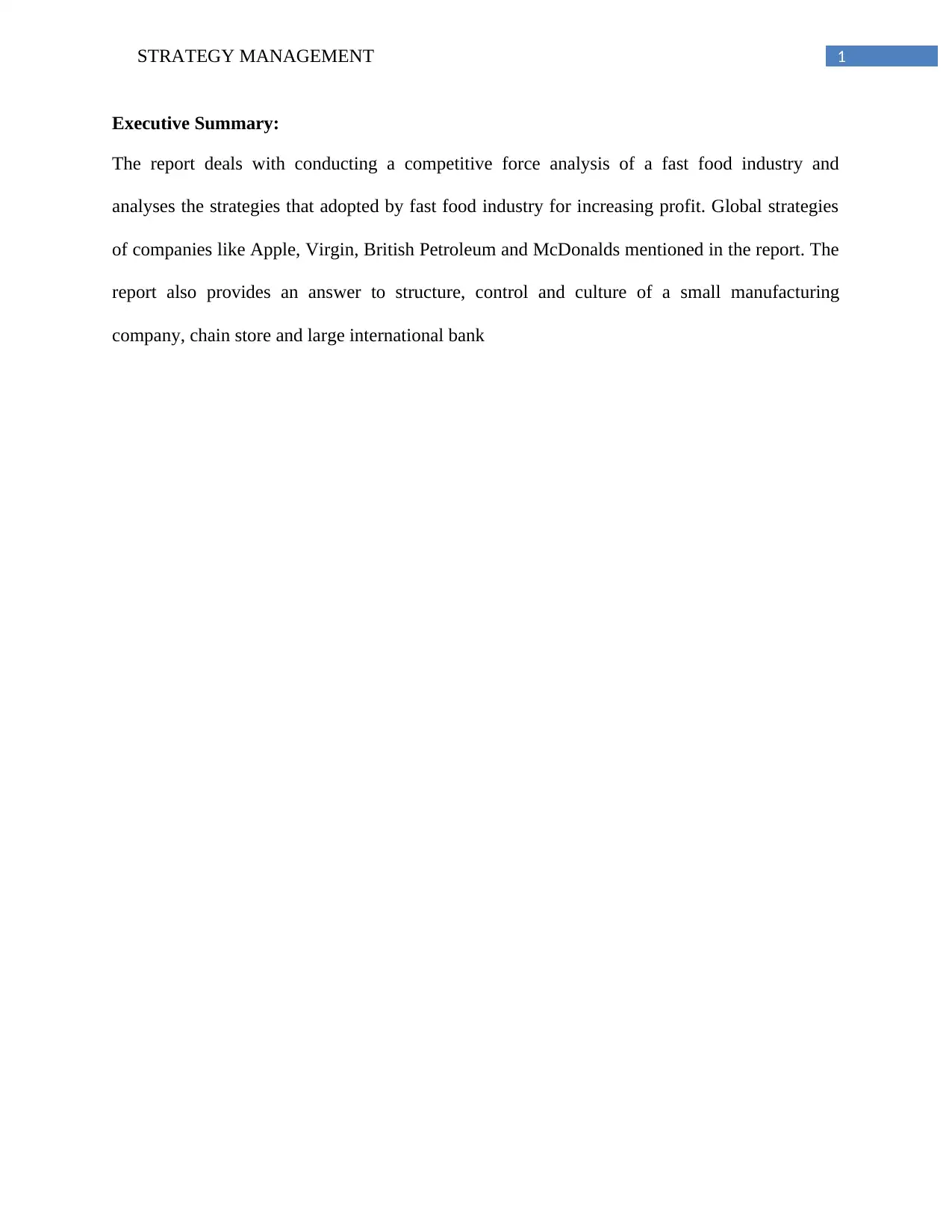
1STRATEGY MANAGEMENT
Executive Summary:
The report deals with conducting a competitive force analysis of a fast food industry and
analyses the strategies that adopted by fast food industry for increasing profit. Global strategies
of companies like Apple, Virgin, British Petroleum and McDonalds mentioned in the report. The
report also provides an answer to structure, control and culture of a small manufacturing
company, chain store and large international bank
Executive Summary:
The report deals with conducting a competitive force analysis of a fast food industry and
analyses the strategies that adopted by fast food industry for increasing profit. Global strategies
of companies like Apple, Virgin, British Petroleum and McDonalds mentioned in the report. The
report also provides an answer to structure, control and culture of a small manufacturing
company, chain store and large international bank
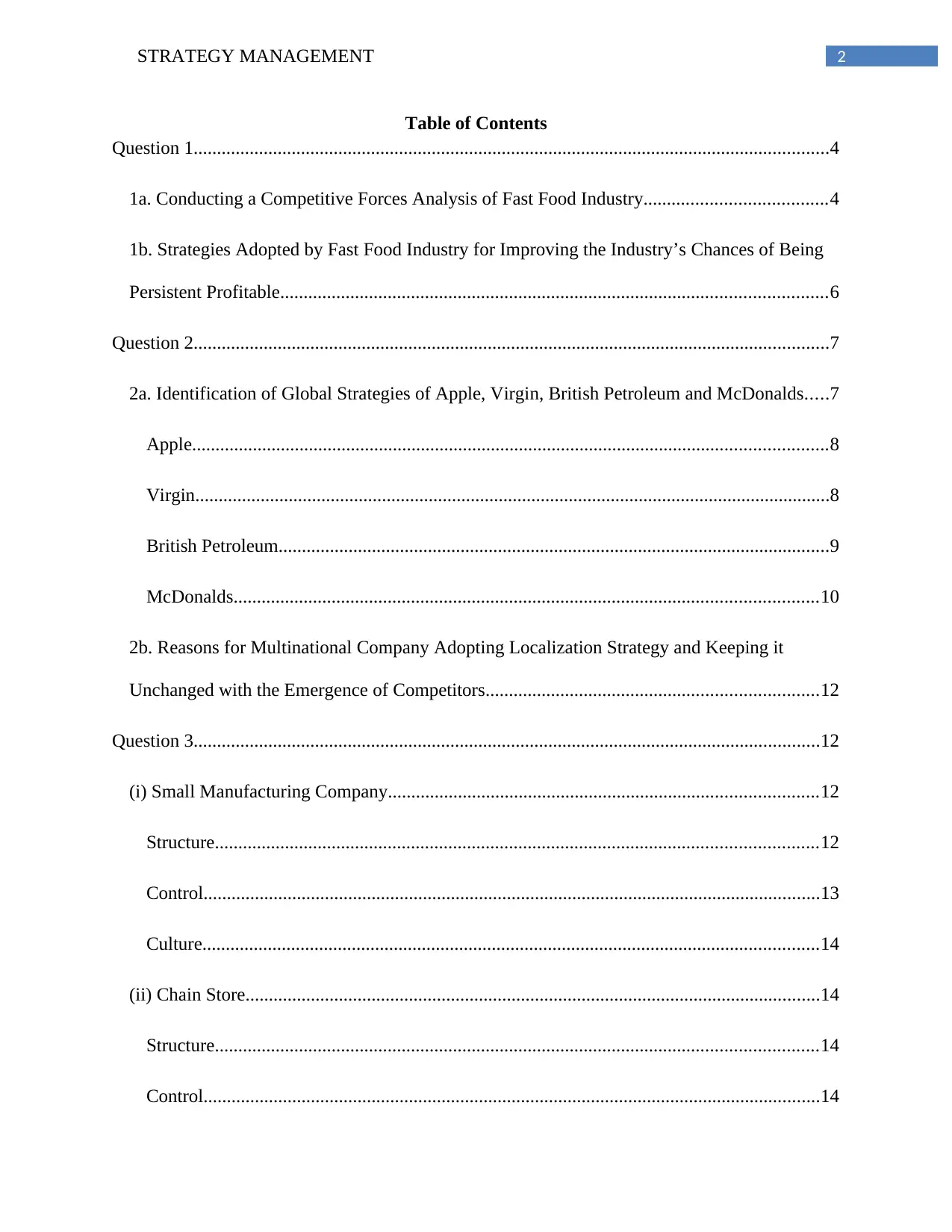
2STRATEGY MANAGEMENT
Table of Contents
Question 1........................................................................................................................................4
1a. Conducting a Competitive Forces Analysis of Fast Food Industry.......................................4
1b. Strategies Adopted by Fast Food Industry for Improving the Industry’s Chances of Being
Persistent Profitable.....................................................................................................................6
Question 2........................................................................................................................................7
2a. Identification of Global Strategies of Apple, Virgin, British Petroleum and McDonalds.....7
Apple........................................................................................................................................8
Virgin........................................................................................................................................8
British Petroleum......................................................................................................................9
McDonalds.............................................................................................................................10
2b. Reasons for Multinational Company Adopting Localization Strategy and Keeping it
Unchanged with the Emergence of Competitors.......................................................................12
Question 3......................................................................................................................................12
(i) Small Manufacturing Company............................................................................................12
Structure.................................................................................................................................12
Control....................................................................................................................................13
Culture....................................................................................................................................14
(ii) Chain Store...........................................................................................................................14
Structure.................................................................................................................................14
Control....................................................................................................................................14
Table of Contents
Question 1........................................................................................................................................4
1a. Conducting a Competitive Forces Analysis of Fast Food Industry.......................................4
1b. Strategies Adopted by Fast Food Industry for Improving the Industry’s Chances of Being
Persistent Profitable.....................................................................................................................6
Question 2........................................................................................................................................7
2a. Identification of Global Strategies of Apple, Virgin, British Petroleum and McDonalds.....7
Apple........................................................................................................................................8
Virgin........................................................................................................................................8
British Petroleum......................................................................................................................9
McDonalds.............................................................................................................................10
2b. Reasons for Multinational Company Adopting Localization Strategy and Keeping it
Unchanged with the Emergence of Competitors.......................................................................12
Question 3......................................................................................................................................12
(i) Small Manufacturing Company............................................................................................12
Structure.................................................................................................................................12
Control....................................................................................................................................13
Culture....................................................................................................................................14
(ii) Chain Store...........................................................................................................................14
Structure.................................................................................................................................14
Control....................................................................................................................................14
⊘ This is a preview!⊘
Do you want full access?
Subscribe today to unlock all pages.

Trusted by 1+ million students worldwide
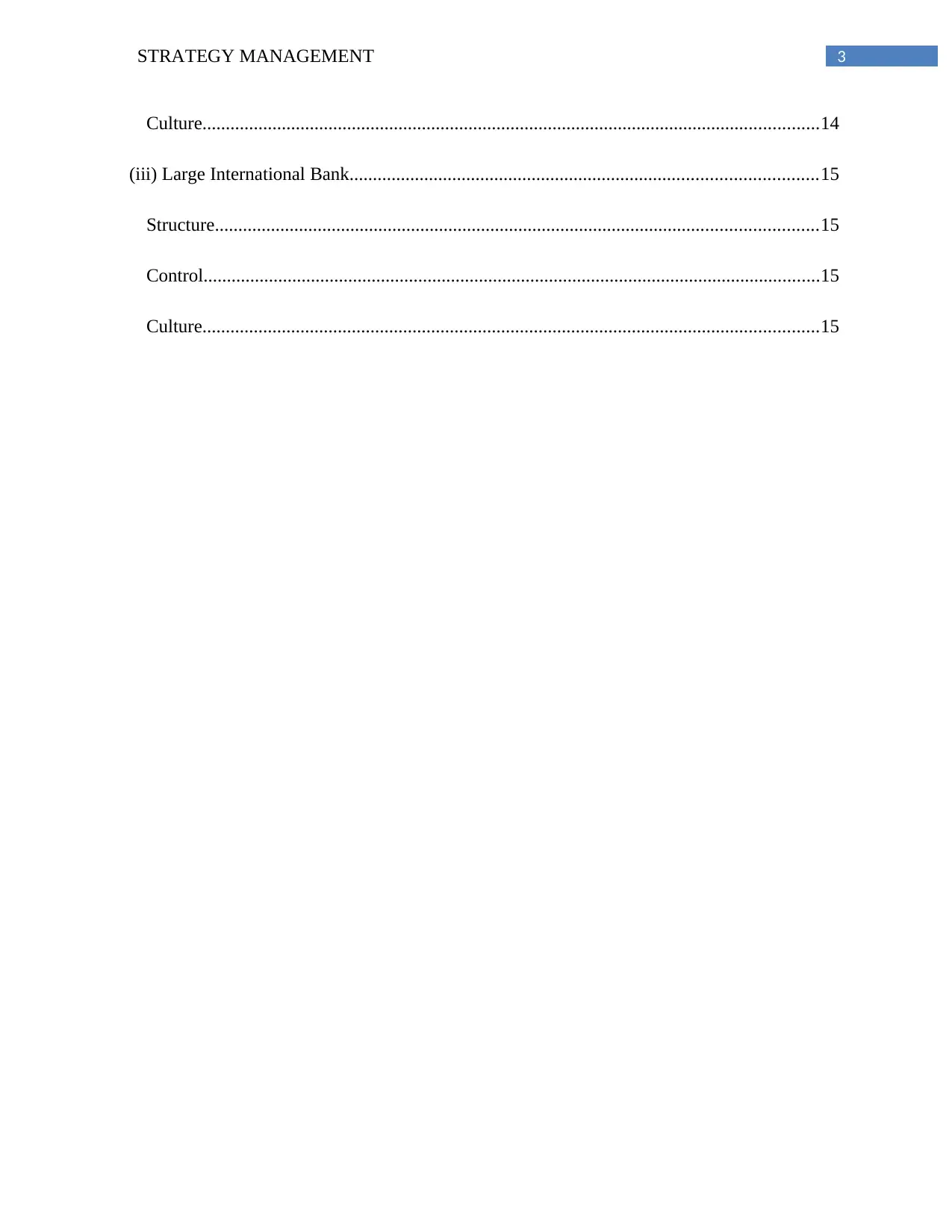
3STRATEGY MANAGEMENT
Culture....................................................................................................................................14
(iii) Large International Bank....................................................................................................15
Structure.................................................................................................................................15
Control....................................................................................................................................15
Culture....................................................................................................................................15
Culture....................................................................................................................................14
(iii) Large International Bank....................................................................................................15
Structure.................................................................................................................................15
Control....................................................................................................................................15
Culture....................................................................................................................................15
Paraphrase This Document
Need a fresh take? Get an instant paraphrase of this document with our AI Paraphraser
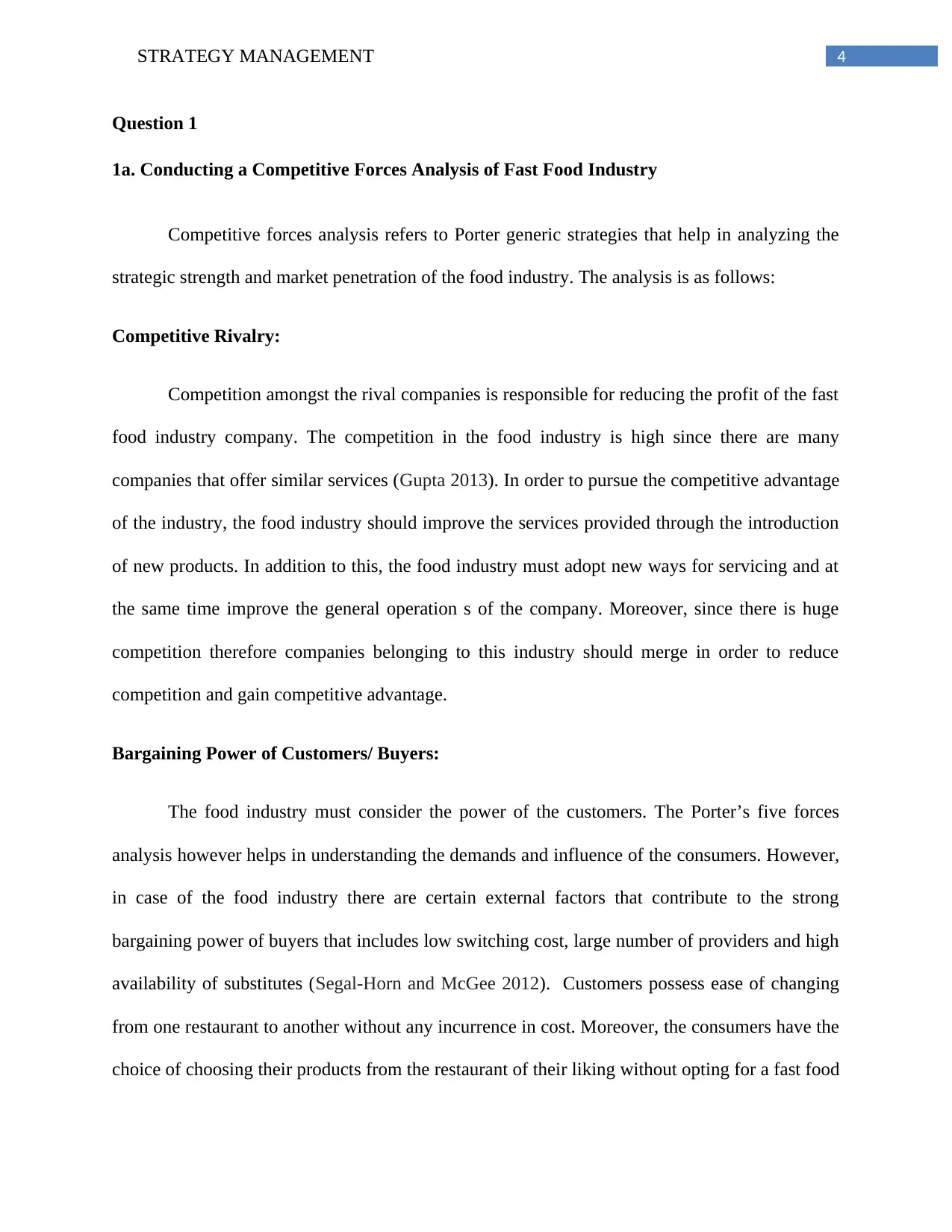
4STRATEGY MANAGEMENT
Question 1
1a. Conducting a Competitive Forces Analysis of Fast Food Industry
Competitive forces analysis refers to Porter generic strategies that help in analyzing the
strategic strength and market penetration of the food industry. The analysis is as follows:
Competitive Rivalry:
Competition amongst the rival companies is responsible for reducing the profit of the fast
food industry company. The competition in the food industry is high since there are many
companies that offer similar services (Gupta 2013). In order to pursue the competitive advantage
of the industry, the food industry should improve the services provided through the introduction
of new products. In addition to this, the food industry must adopt new ways for servicing and at
the same time improve the general operation s of the company. Moreover, since there is huge
competition therefore companies belonging to this industry should merge in order to reduce
competition and gain competitive advantage.
Bargaining Power of Customers/ Buyers:
The food industry must consider the power of the customers. The Porter’s five forces
analysis however helps in understanding the demands and influence of the consumers. However,
in case of the food industry there are certain external factors that contribute to the strong
bargaining power of buyers that includes low switching cost, large number of providers and high
availability of substitutes (Segal-Horn and McGee 2012). Customers possess ease of changing
from one restaurant to another without any incurrence in cost. Moreover, the consumers have the
choice of choosing their products from the restaurant of their liking without opting for a fast food
Question 1
1a. Conducting a Competitive Forces Analysis of Fast Food Industry
Competitive forces analysis refers to Porter generic strategies that help in analyzing the
strategic strength and market penetration of the food industry. The analysis is as follows:
Competitive Rivalry:
Competition amongst the rival companies is responsible for reducing the profit of the fast
food industry company. The competition in the food industry is high since there are many
companies that offer similar services (Gupta 2013). In order to pursue the competitive advantage
of the industry, the food industry should improve the services provided through the introduction
of new products. In addition to this, the food industry must adopt new ways for servicing and at
the same time improve the general operation s of the company. Moreover, since there is huge
competition therefore companies belonging to this industry should merge in order to reduce
competition and gain competitive advantage.
Bargaining Power of Customers/ Buyers:
The food industry must consider the power of the customers. The Porter’s five forces
analysis however helps in understanding the demands and influence of the consumers. However,
in case of the food industry there are certain external factors that contribute to the strong
bargaining power of buyers that includes low switching cost, large number of providers and high
availability of substitutes (Segal-Horn and McGee 2012). Customers possess ease of changing
from one restaurant to another without any incurrence in cost. Moreover, the consumers have the
choice of choosing their products from the restaurant of their liking without opting for a fast food
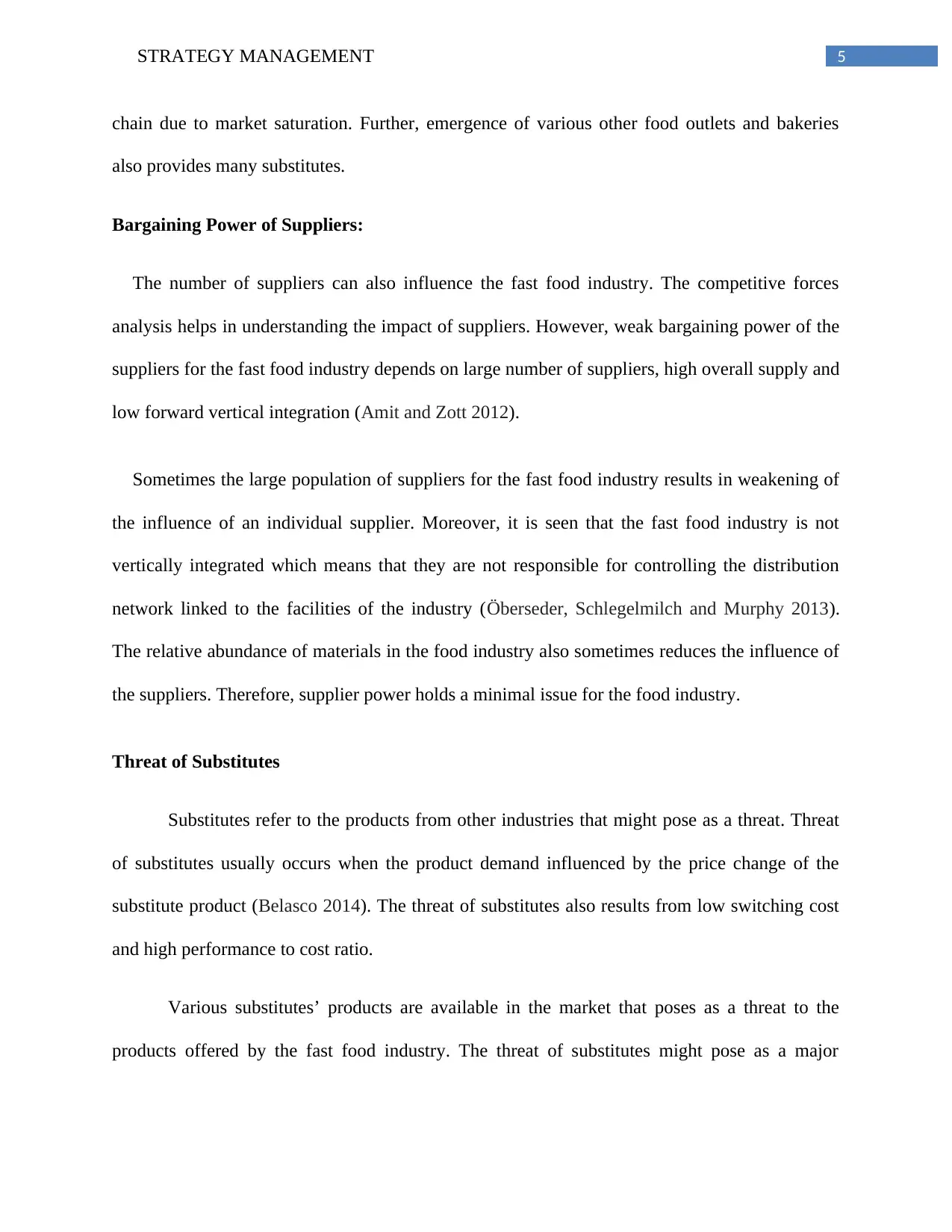
5STRATEGY MANAGEMENT
chain due to market saturation. Further, emergence of various other food outlets and bakeries
also provides many substitutes.
Bargaining Power of Suppliers:
The number of suppliers can also influence the fast food industry. The competitive forces
analysis helps in understanding the impact of suppliers. However, weak bargaining power of the
suppliers for the fast food industry depends on large number of suppliers, high overall supply and
low forward vertical integration (Amit and Zott 2012).
Sometimes the large population of suppliers for the fast food industry results in weakening of
the influence of an individual supplier. Moreover, it is seen that the fast food industry is not
vertically integrated which means that they are not responsible for controlling the distribution
network linked to the facilities of the industry (Öberseder, Schlegelmilch and Murphy 2013).
The relative abundance of materials in the food industry also sometimes reduces the influence of
the suppliers. Therefore, supplier power holds a minimal issue for the food industry.
Threat of Substitutes
Substitutes refer to the products from other industries that might pose as a threat. Threat
of substitutes usually occurs when the product demand influenced by the price change of the
substitute product (Belasco 2014). The threat of substitutes also results from low switching cost
and high performance to cost ratio.
Various substitutes’ products are available in the market that poses as a threat to the
products offered by the fast food industry. The threat of substitutes might pose as a major
chain due to market saturation. Further, emergence of various other food outlets and bakeries
also provides many substitutes.
Bargaining Power of Suppliers:
The number of suppliers can also influence the fast food industry. The competitive forces
analysis helps in understanding the impact of suppliers. However, weak bargaining power of the
suppliers for the fast food industry depends on large number of suppliers, high overall supply and
low forward vertical integration (Amit and Zott 2012).
Sometimes the large population of suppliers for the fast food industry results in weakening of
the influence of an individual supplier. Moreover, it is seen that the fast food industry is not
vertically integrated which means that they are not responsible for controlling the distribution
network linked to the facilities of the industry (Öberseder, Schlegelmilch and Murphy 2013).
The relative abundance of materials in the food industry also sometimes reduces the influence of
the suppliers. Therefore, supplier power holds a minimal issue for the food industry.
Threat of Substitutes
Substitutes refer to the products from other industries that might pose as a threat. Threat
of substitutes usually occurs when the product demand influenced by the price change of the
substitute product (Belasco 2014). The threat of substitutes also results from low switching cost
and high performance to cost ratio.
Various substitutes’ products are available in the market that poses as a threat to the
products offered by the fast food industry. The threat of substitutes might pose as a major
⊘ This is a preview!⊘
Do you want full access?
Subscribe today to unlock all pages.

Trusted by 1+ million students worldwide
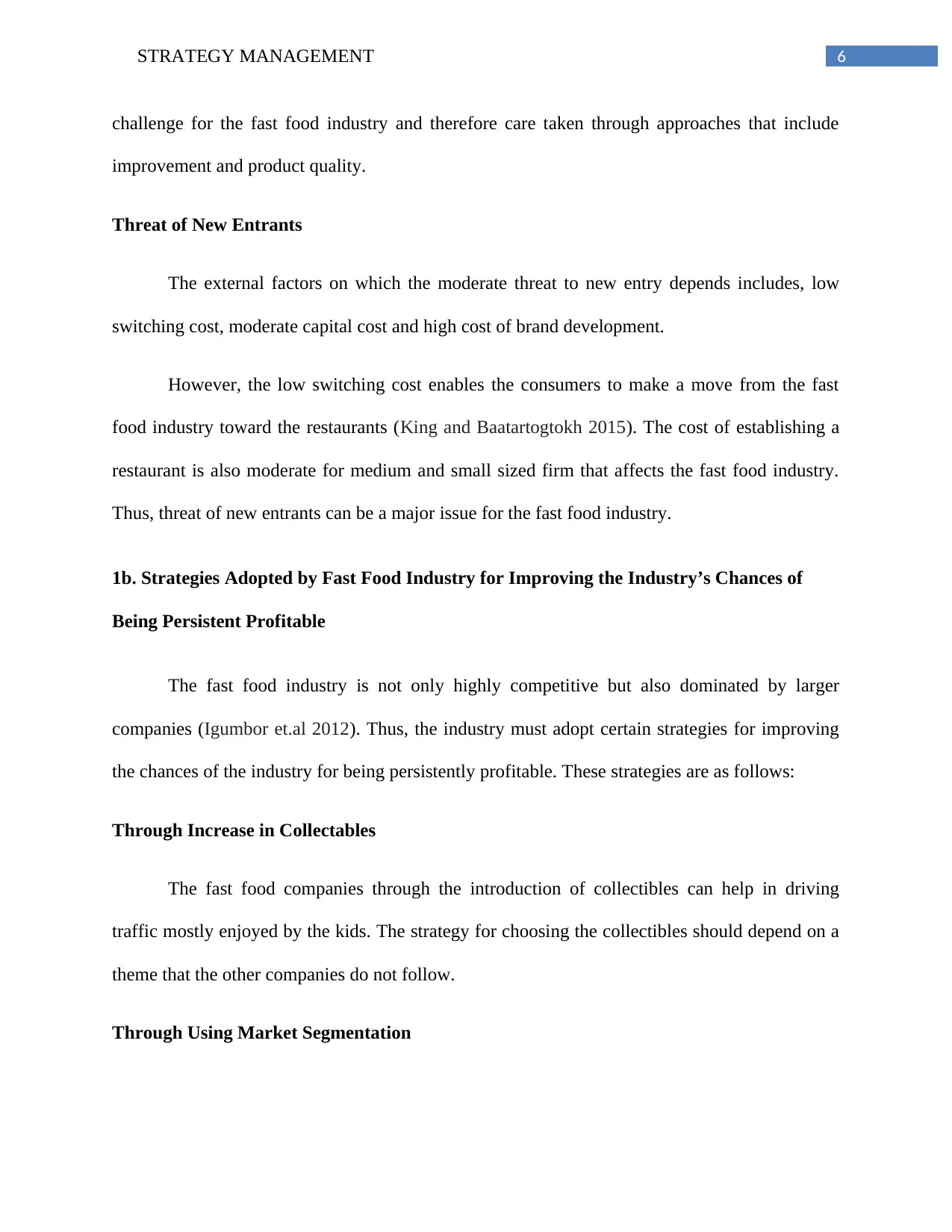
6STRATEGY MANAGEMENT
challenge for the fast food industry and therefore care taken through approaches that include
improvement and product quality.
Threat of New Entrants
The external factors on which the moderate threat to new entry depends includes, low
switching cost, moderate capital cost and high cost of brand development.
However, the low switching cost enables the consumers to make a move from the fast
food industry toward the restaurants (King and Baatartogtokh 2015). The cost of establishing a
restaurant is also moderate for medium and small sized firm that affects the fast food industry.
Thus, threat of new entrants can be a major issue for the fast food industry.
1b. Strategies Adopted by Fast Food Industry for Improving the Industry’s Chances of
Being Persistent Profitable
The fast food industry is not only highly competitive but also dominated by larger
companies (Igumbor et.al 2012). Thus, the industry must adopt certain strategies for improving
the chances of the industry for being persistently profitable. These strategies are as follows:
Through Increase in Collectables
The fast food companies through the introduction of collectibles can help in driving
traffic mostly enjoyed by the kids. The strategy for choosing the collectibles should depend on a
theme that the other companies do not follow.
Through Using Market Segmentation
challenge for the fast food industry and therefore care taken through approaches that include
improvement and product quality.
Threat of New Entrants
The external factors on which the moderate threat to new entry depends includes, low
switching cost, moderate capital cost and high cost of brand development.
However, the low switching cost enables the consumers to make a move from the fast
food industry toward the restaurants (King and Baatartogtokh 2015). The cost of establishing a
restaurant is also moderate for medium and small sized firm that affects the fast food industry.
Thus, threat of new entrants can be a major issue for the fast food industry.
1b. Strategies Adopted by Fast Food Industry for Improving the Industry’s Chances of
Being Persistent Profitable
The fast food industry is not only highly competitive but also dominated by larger
companies (Igumbor et.al 2012). Thus, the industry must adopt certain strategies for improving
the chances of the industry for being persistently profitable. These strategies are as follows:
Through Increase in Collectables
The fast food companies through the introduction of collectibles can help in driving
traffic mostly enjoyed by the kids. The strategy for choosing the collectibles should depend on a
theme that the other companies do not follow.
Through Using Market Segmentation
Paraphrase This Document
Need a fresh take? Get an instant paraphrase of this document with our AI Paraphraser
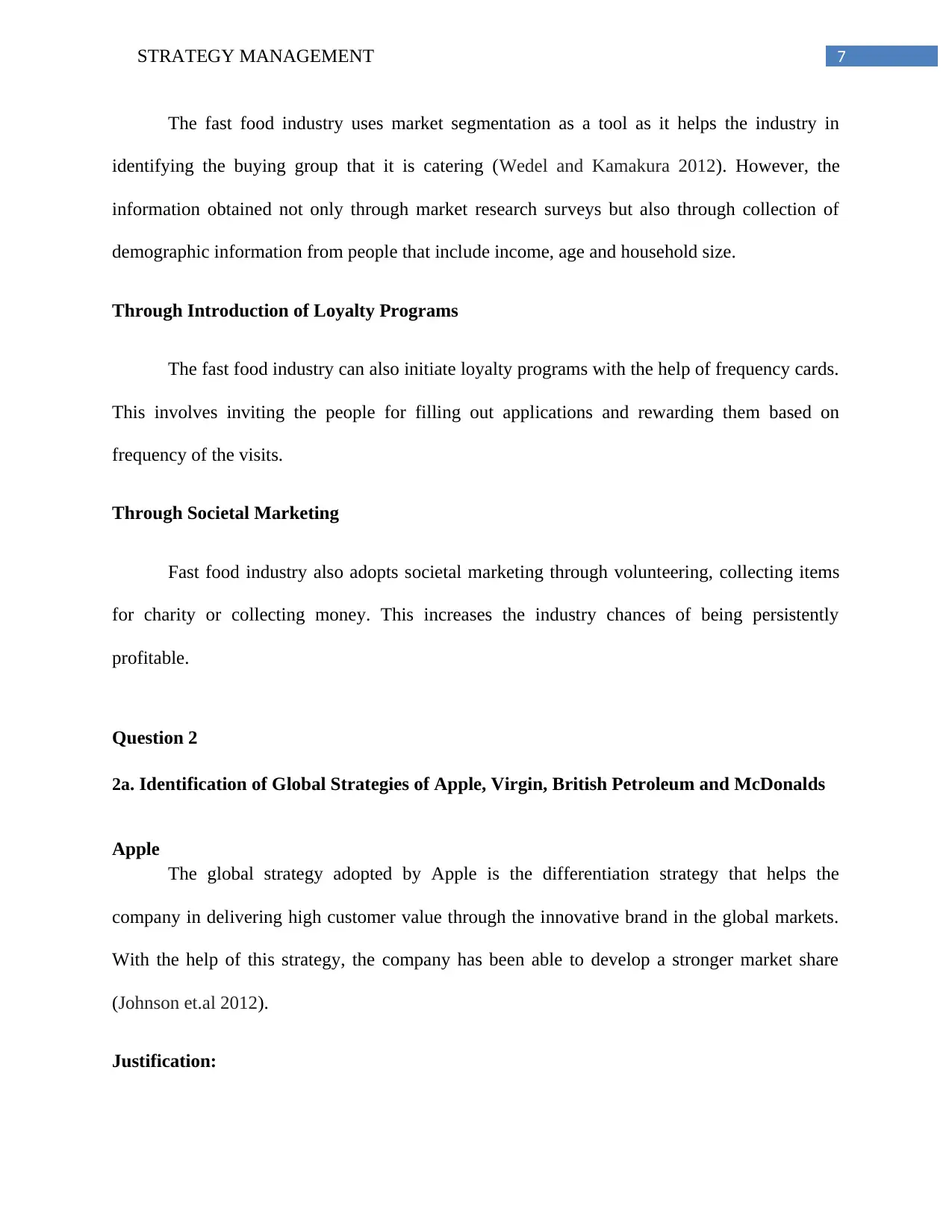
7STRATEGY MANAGEMENT
The fast food industry uses market segmentation as a tool as it helps the industry in
identifying the buying group that it is catering (Wedel and Kamakura 2012). However, the
information obtained not only through market research surveys but also through collection of
demographic information from people that include income, age and household size.
Through Introduction of Loyalty Programs
The fast food industry can also initiate loyalty programs with the help of frequency cards.
This involves inviting the people for filling out applications and rewarding them based on
frequency of the visits.
Through Societal Marketing
Fast food industry also adopts societal marketing through volunteering, collecting items
for charity or collecting money. This increases the industry chances of being persistently
profitable.
Question 2
2a. Identification of Global Strategies of Apple, Virgin, British Petroleum and McDonalds
Apple
The global strategy adopted by Apple is the differentiation strategy that helps the
company in delivering high customer value through the innovative brand in the global markets.
With the help of this strategy, the company has been able to develop a stronger market share
(Johnson et.al 2012).
Justification:
The fast food industry uses market segmentation as a tool as it helps the industry in
identifying the buying group that it is catering (Wedel and Kamakura 2012). However, the
information obtained not only through market research surveys but also through collection of
demographic information from people that include income, age and household size.
Through Introduction of Loyalty Programs
The fast food industry can also initiate loyalty programs with the help of frequency cards.
This involves inviting the people for filling out applications and rewarding them based on
frequency of the visits.
Through Societal Marketing
Fast food industry also adopts societal marketing through volunteering, collecting items
for charity or collecting money. This increases the industry chances of being persistently
profitable.
Question 2
2a. Identification of Global Strategies of Apple, Virgin, British Petroleum and McDonalds
Apple
The global strategy adopted by Apple is the differentiation strategy that helps the
company in delivering high customer value through the innovative brand in the global markets.
With the help of this strategy, the company has been able to develop a stronger market share
(Johnson et.al 2012).
Justification:
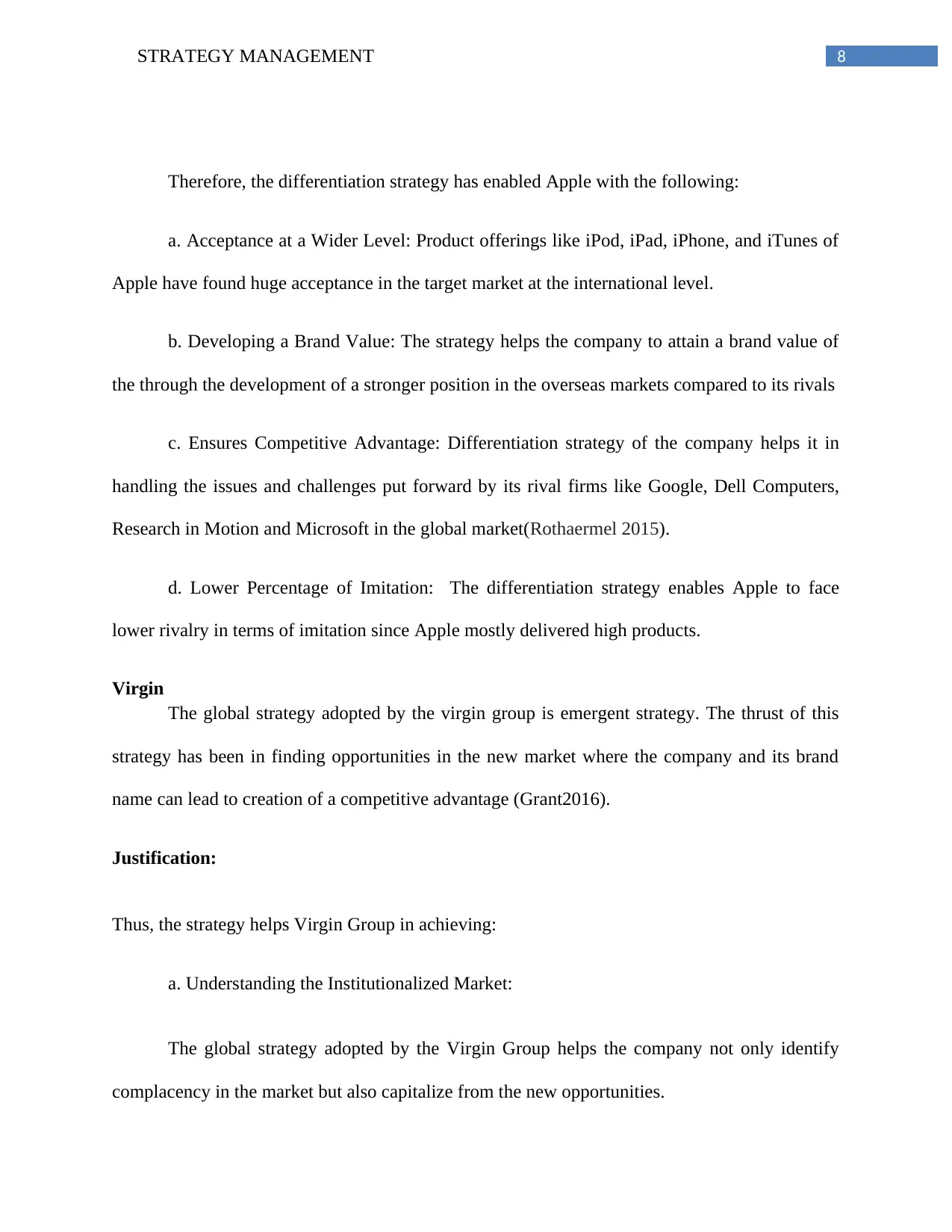
8STRATEGY MANAGEMENT
Therefore, the differentiation strategy has enabled Apple with the following:
a. Acceptance at a Wider Level: Product offerings like iPod, iPad, iPhone, and iTunes of
Apple have found huge acceptance in the target market at the international level.
b. Developing a Brand Value: The strategy helps the company to attain a brand value of
the through the development of a stronger position in the overseas markets compared to its rivals
c. Ensures Competitive Advantage: Differentiation strategy of the company helps it in
handling the issues and challenges put forward by its rival firms like Google, Dell Computers,
Research in Motion and Microsoft in the global market(Rothaermel 2015).
d. Lower Percentage of Imitation: The differentiation strategy enables Apple to face
lower rivalry in terms of imitation since Apple mostly delivered high products.
Virgin
The global strategy adopted by the virgin group is emergent strategy. The thrust of this
strategy has been in finding opportunities in the new market where the company and its brand
name can lead to creation of a competitive advantage (Grant2016).
Justification:
Thus, the strategy helps Virgin Group in achieving:
a. Understanding the Institutionalized Market:
The global strategy adopted by the Virgin Group helps the company not only identify
complacency in the market but also capitalize from the new opportunities.
Therefore, the differentiation strategy has enabled Apple with the following:
a. Acceptance at a Wider Level: Product offerings like iPod, iPad, iPhone, and iTunes of
Apple have found huge acceptance in the target market at the international level.
b. Developing a Brand Value: The strategy helps the company to attain a brand value of
the through the development of a stronger position in the overseas markets compared to its rivals
c. Ensures Competitive Advantage: Differentiation strategy of the company helps it in
handling the issues and challenges put forward by its rival firms like Google, Dell Computers,
Research in Motion and Microsoft in the global market(Rothaermel 2015).
d. Lower Percentage of Imitation: The differentiation strategy enables Apple to face
lower rivalry in terms of imitation since Apple mostly delivered high products.
Virgin
The global strategy adopted by the virgin group is emergent strategy. The thrust of this
strategy has been in finding opportunities in the new market where the company and its brand
name can lead to creation of a competitive advantage (Grant2016).
Justification:
Thus, the strategy helps Virgin Group in achieving:
a. Understanding the Institutionalized Market:
The global strategy adopted by the Virgin Group helps the company not only identify
complacency in the market but also capitalize from the new opportunities.
⊘ This is a preview!⊘
Do you want full access?
Subscribe today to unlock all pages.

Trusted by 1+ million students worldwide
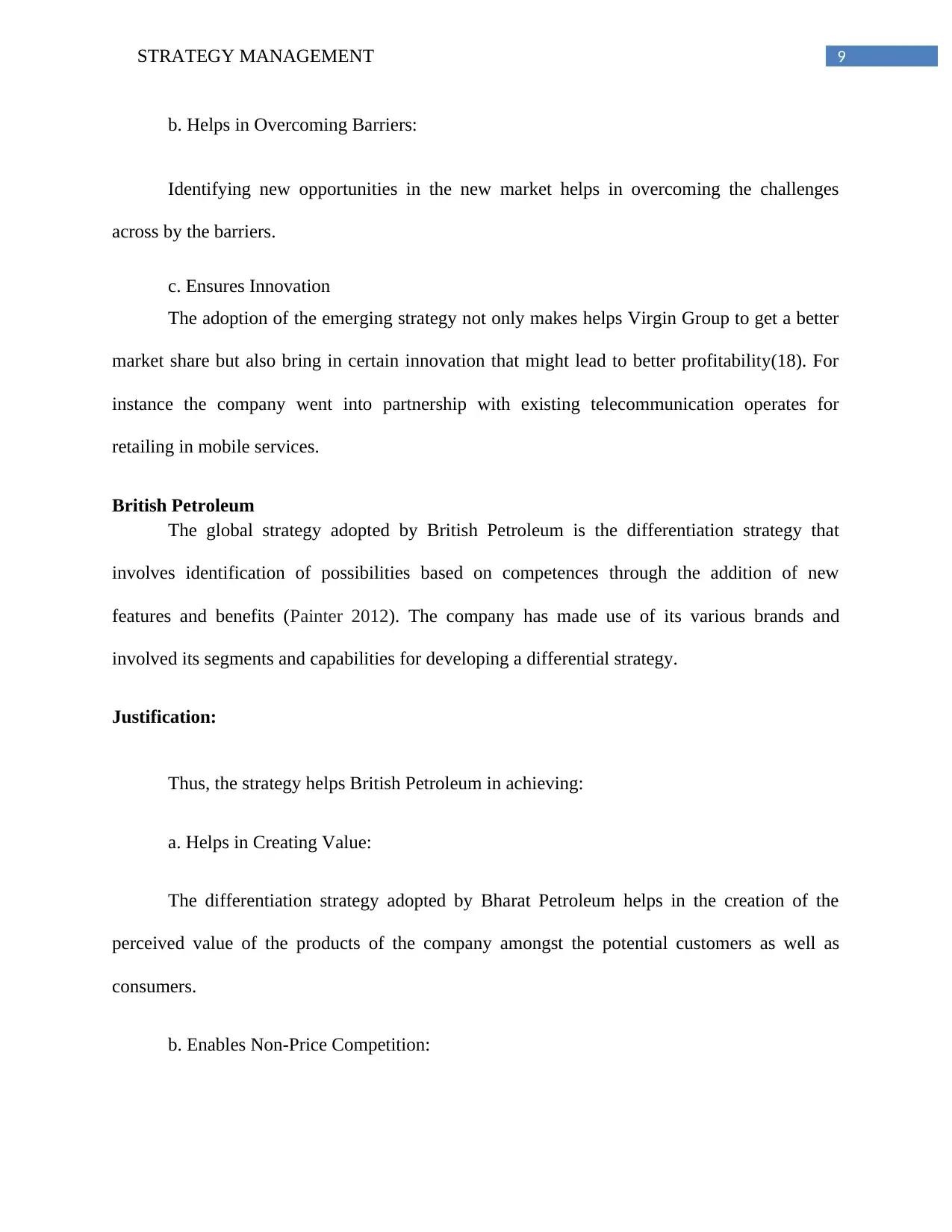
9STRATEGY MANAGEMENT
b. Helps in Overcoming Barriers:
Identifying new opportunities in the new market helps in overcoming the challenges
across by the barriers.
c. Ensures Innovation
The adoption of the emerging strategy not only makes helps Virgin Group to get a better
market share but also bring in certain innovation that might lead to better profitability(18). For
instance the company went into partnership with existing telecommunication operates for
retailing in mobile services.
British Petroleum
The global strategy adopted by British Petroleum is the differentiation strategy that
involves identification of possibilities based on competences through the addition of new
features and benefits (Painter 2012). The company has made use of its various brands and
involved its segments and capabilities for developing a differential strategy.
Justification:
Thus, the strategy helps British Petroleum in achieving:
a. Helps in Creating Value:
The differentiation strategy adopted by Bharat Petroleum helps in the creation of the
perceived value of the products of the company amongst the potential customers as well as
consumers.
b. Enables Non-Price Competition:
b. Helps in Overcoming Barriers:
Identifying new opportunities in the new market helps in overcoming the challenges
across by the barriers.
c. Ensures Innovation
The adoption of the emerging strategy not only makes helps Virgin Group to get a better
market share but also bring in certain innovation that might lead to better profitability(18). For
instance the company went into partnership with existing telecommunication operates for
retailing in mobile services.
British Petroleum
The global strategy adopted by British Petroleum is the differentiation strategy that
involves identification of possibilities based on competences through the addition of new
features and benefits (Painter 2012). The company has made use of its various brands and
involved its segments and capabilities for developing a differential strategy.
Justification:
Thus, the strategy helps British Petroleum in achieving:
a. Helps in Creating Value:
The differentiation strategy adopted by Bharat Petroleum helps in the creation of the
perceived value of the products of the company amongst the potential customers as well as
consumers.
b. Enables Non-Price Competition:
Paraphrase This Document
Need a fresh take? Get an instant paraphrase of this document with our AI Paraphraser
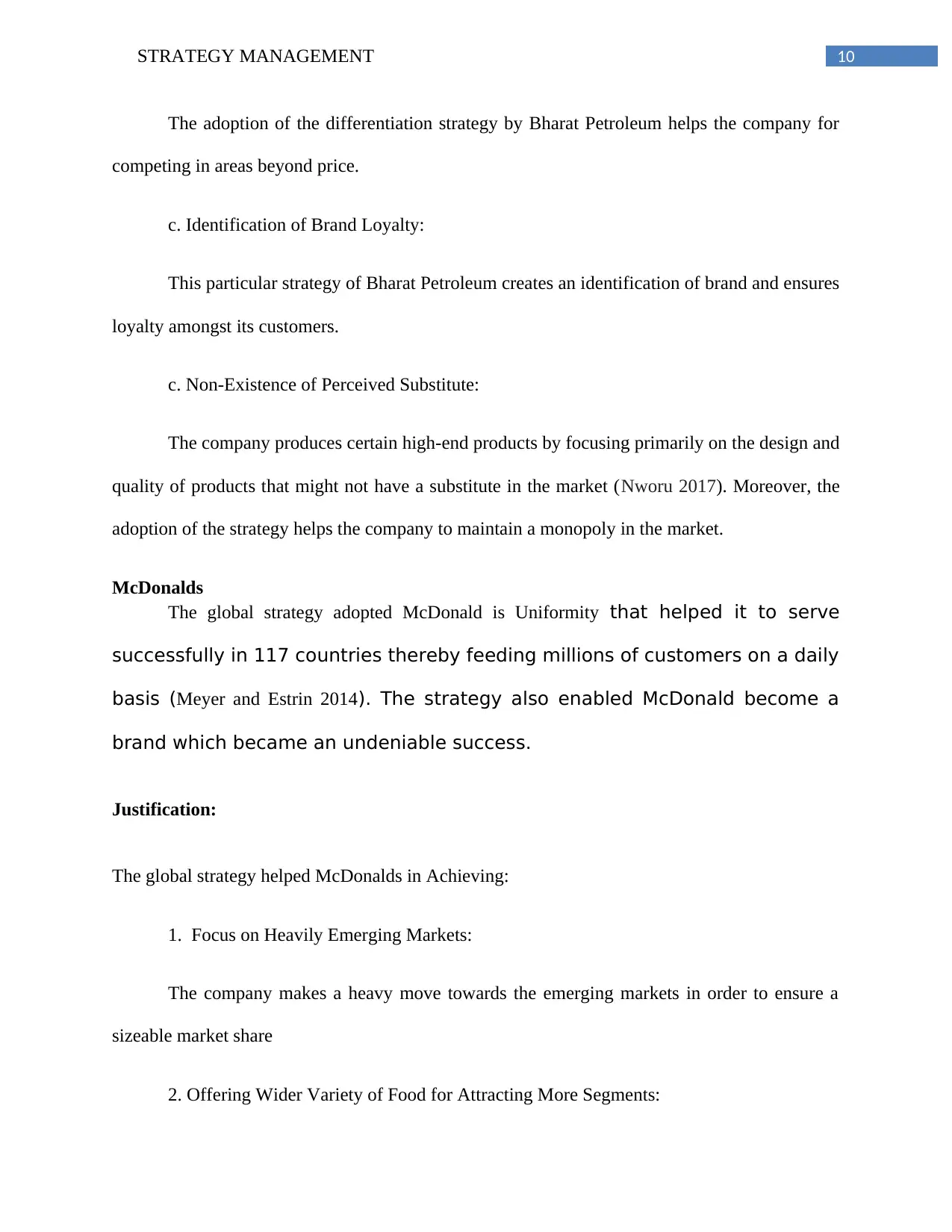
10STRATEGY MANAGEMENT
The adoption of the differentiation strategy by Bharat Petroleum helps the company for
competing in areas beyond price.
c. Identification of Brand Loyalty:
This particular strategy of Bharat Petroleum creates an identification of brand and ensures
loyalty amongst its customers.
c. Non-Existence of Perceived Substitute:
The company produces certain high-end products by focusing primarily on the design and
quality of products that might not have a substitute in the market (Nworu 2017). Moreover, the
adoption of the strategy helps the company to maintain a monopoly in the market.
McDonalds
The global strategy adopted McDonald is Uniformity that helped it to serve
successfully in 117 countries thereby feeding millions of customers on a daily
basis (Meyer and Estrin 2014). The strategy also enabled McDonald become a
brand which became an undeniable success.
Justification:
The global strategy helped McDonalds in Achieving:
1. Focus on Heavily Emerging Markets:
The company makes a heavy move towards the emerging markets in order to ensure a
sizeable market share
2. Offering Wider Variety of Food for Attracting More Segments:
The adoption of the differentiation strategy by Bharat Petroleum helps the company for
competing in areas beyond price.
c. Identification of Brand Loyalty:
This particular strategy of Bharat Petroleum creates an identification of brand and ensures
loyalty amongst its customers.
c. Non-Existence of Perceived Substitute:
The company produces certain high-end products by focusing primarily on the design and
quality of products that might not have a substitute in the market (Nworu 2017). Moreover, the
adoption of the strategy helps the company to maintain a monopoly in the market.
McDonalds
The global strategy adopted McDonald is Uniformity that helped it to serve
successfully in 117 countries thereby feeding millions of customers on a daily
basis (Meyer and Estrin 2014). The strategy also enabled McDonald become a
brand which became an undeniable success.
Justification:
The global strategy helped McDonalds in Achieving:
1. Focus on Heavily Emerging Markets:
The company makes a heavy move towards the emerging markets in order to ensure a
sizeable market share
2. Offering Wider Variety of Food for Attracting More Segments:
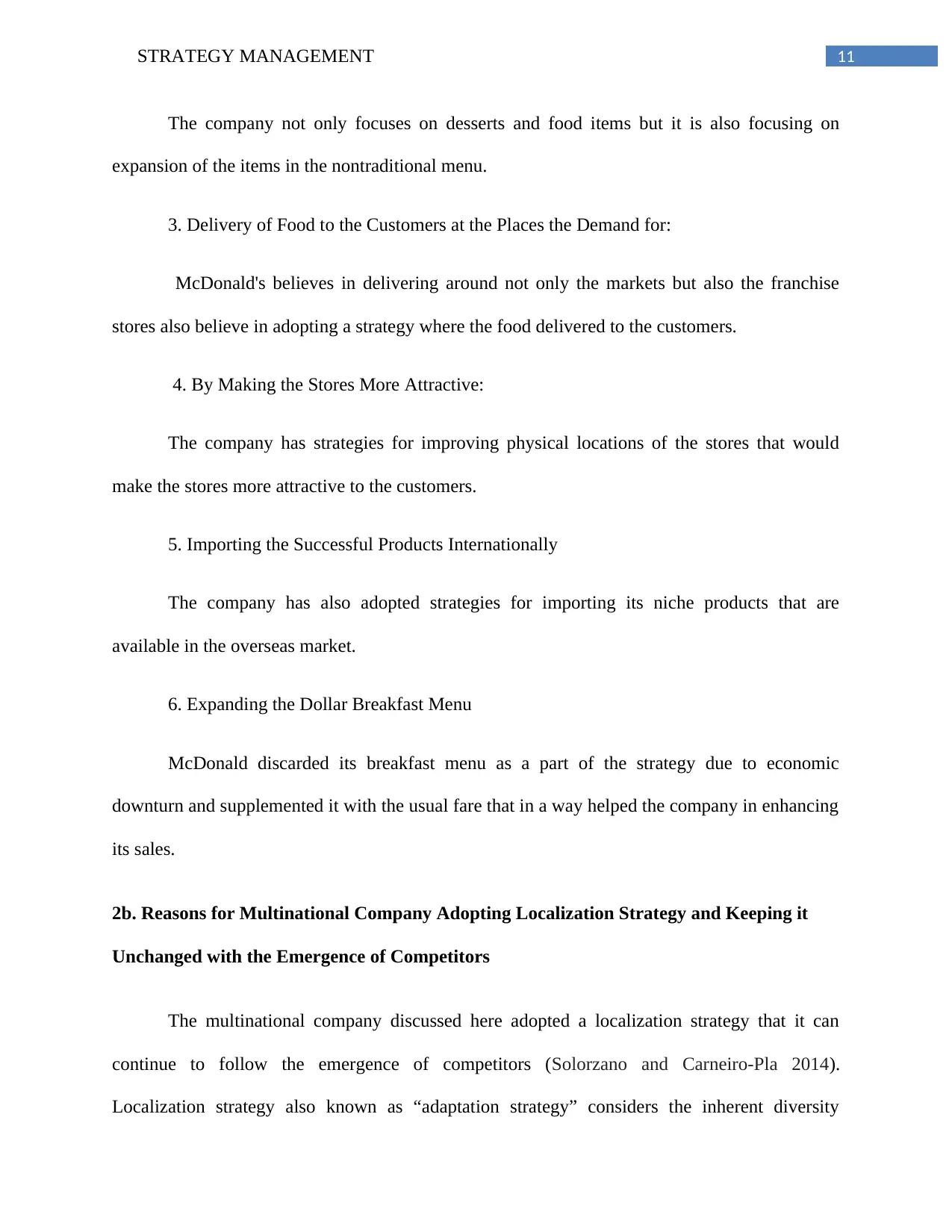
11STRATEGY MANAGEMENT
The company not only focuses on desserts and food items but it is also focusing on
expansion of the items in the nontraditional menu.
3. Delivery of Food to the Customers at the Places the Demand for:
McDonald's believes in delivering around not only the markets but also the franchise
stores also believe in adopting a strategy where the food delivered to the customers.
4. By Making the Stores More Attractive:
The company has strategies for improving physical locations of the stores that would
make the stores more attractive to the customers.
5. Importing the Successful Products Internationally
The company has also adopted strategies for importing its niche products that are
available in the overseas market.
6. Expanding the Dollar Breakfast Menu
McDonald discarded its breakfast menu as a part of the strategy due to economic
downturn and supplemented it with the usual fare that in a way helped the company in enhancing
its sales.
2b. Reasons for Multinational Company Adopting Localization Strategy and Keeping it
Unchanged with the Emergence of Competitors
The multinational company discussed here adopted a localization strategy that it can
continue to follow the emergence of competitors (Solorzano and Carneiro-Pla 2014).
Localization strategy also known as “adaptation strategy” considers the inherent diversity
The company not only focuses on desserts and food items but it is also focusing on
expansion of the items in the nontraditional menu.
3. Delivery of Food to the Customers at the Places the Demand for:
McDonald's believes in delivering around not only the markets but also the franchise
stores also believe in adopting a strategy where the food delivered to the customers.
4. By Making the Stores More Attractive:
The company has strategies for improving physical locations of the stores that would
make the stores more attractive to the customers.
5. Importing the Successful Products Internationally
The company has also adopted strategies for importing its niche products that are
available in the overseas market.
6. Expanding the Dollar Breakfast Menu
McDonald discarded its breakfast menu as a part of the strategy due to economic
downturn and supplemented it with the usual fare that in a way helped the company in enhancing
its sales.
2b. Reasons for Multinational Company Adopting Localization Strategy and Keeping it
Unchanged with the Emergence of Competitors
The multinational company discussed here adopted a localization strategy that it can
continue to follow the emergence of competitors (Solorzano and Carneiro-Pla 2014).
Localization strategy also known as “adaptation strategy” considers the inherent diversity
⊘ This is a preview!⊘
Do you want full access?
Subscribe today to unlock all pages.

Trusted by 1+ million students worldwide
1 out of 20
Related Documents
Your All-in-One AI-Powered Toolkit for Academic Success.
+13062052269
info@desklib.com
Available 24*7 on WhatsApp / Email
![[object Object]](/_next/static/media/star-bottom.7253800d.svg)
Unlock your academic potential
Copyright © 2020–2025 A2Z Services. All Rights Reserved. Developed and managed by ZUCOL.





